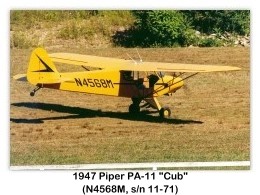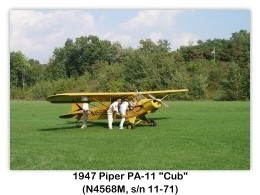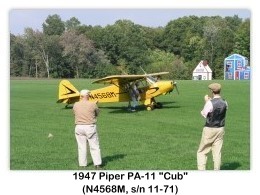
| ||||
|---|---|---|---|---|
 |
 |
 |
 |
 |



























| ||||
|---|---|---|---|---|
 |
 |
 |
 |
 |


























Piper PA-11 Cub
Single-engine two-seat high-wing civil monoplane
Archive Photos 1
Piper PA-11 Cub (N4568M, s/n 11-71, 1947) c.1998 performing at the Old Rhinebeck Aerodrome, Rhinebeck, New York (Photos by John Shupek)



Piper PA-11 Cub (N4568M, s/n 11-71, 1947) c.2004 performing at the Old Rhinebeck Aerodrome, Rhinebeck, New York (Photos by John Shupek)








Overview 2
The Piper PA-11 Cub Special is a later production, two-place variant of the Piper J-3 Cub light propeller-driven aircraft, manufactured by Piper Aircraft.
Design and Development 2
The airframe is basically the same as a Piper J-3, but the engine mount is slightly lower, the windshield more sloped, the cowling is fully closed and the fuel tank was raised and placed in the port wing. Both seats were slightly moved Back, and solo flying was usually from the front seat. Early PA-11’s had a Continental A65-8 engine, while the later ones had the option of a Continental C90-8.
Several current-production light-sport aircraft are being produced based on this configuration. On the early PA-11’s, the fuselage was painted with a metallic blue on the lower half the rest being Lock Haven Yellow. The later PA-11’s were all yellow with a simple brown stripe.
The aircraft formed the basis for the next evolution in the Piper Cub series: The Piper PA-18 I. The PA-11 and its successor, the PA-18-95, share many common traits. With a gross weight of 1,220 lbs. and average empty weight of 850 lbs., the PA-11 is a light enough to perform well, yet heavy enough to maneuver easily in more wind than the lighter J-3 Cub. The PA-11 is capable of short takeoffs and landings, yet has a respectable cruise speed for its configuration. Given that the PA-11 falls into the modern day category of light sport aircraft it is a popular airplane to acquire and commands a premium price.
Modifications 2
The PA-11 was one of the first aircraft to be used in experiments with the nose-wheel (also known as tricycle gear) configuration. Although its original design is intended to be a tail-dragger, a modification was created to mount a nosewheel onto the front of the aircraft. The nose-wheel is attached to the two rear engine mounts by y-shaped steel tubes attached to a steel tube with a shaft that slides freely with the wheel. Cables ran underneath the belly directly from fixtures on the rudder pedals to the nosewheel shaft. This gave the ability to steer by pivoting the nosewheel shaft with the rudder pedals. The shock system consisted of six circular bungee chords, sometimes four for softer landings, located on either side of the nosewheel shaft to ears on the top tube and the bottom shaft connected to the wheel. In order for the aircraft to balance properly with the nosewheel, the main gear was flipped around so that the center of balance would move forward. The pilot would sit in the front seat for added balance. Most PA-11’s in service today retain the original tailwheel undercarriage layout.
Variants 2
Military Operators 2
Specifications (PA-11) 3
Type
Wings
Fuselage
Tail Unit
Landing Gear
Power Plant
Accommodation
Dimensions
Areas
Weights
Loadings
Performance
References